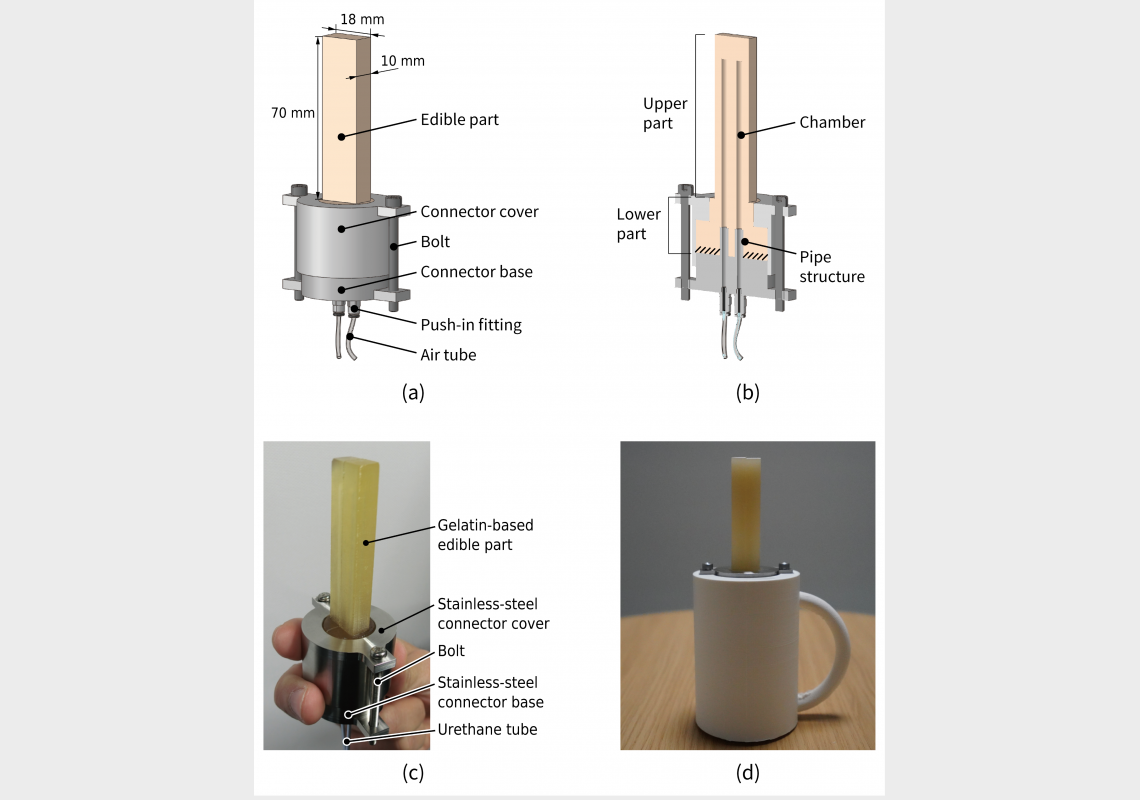Edible robot: (a) three-dimensional computer-aided design model, (b) internal structure, (c) photograph of the edible robot, (d) the edible robot with a three-dimensional printed handle.
In a landmark study, Associate Professor Yoshihiro Nakata of the University of Electro-Communications, Japan, in collaboration with researchers from Osaka University, conducted groundbreaking research on edible robotics. Published in PLOS ONE, this study is the first to explore the experience of consuming a moving edible robot.
Drawing inspiration from traditional Japanese culinary practices like Odorigui, which involves eating live seafood, this research extends these cultural concepts into the domain of robotics. The team developed a pneumatically-driven robot made of gelatin and sugar, focusing on creating an experience that merges the animate with the edible, reminiscent of the dynamism found in Odorigui.
The study comprised two experiments. The first experiment assessed participants' impressions based solely on observing the robot's movements, without eating. This phase provided valuable insights into how the perceived animateness of the robot impacts the hypothetical eating experience.
In the second experiment, each participant experienced both conditions: eating the robot while it was in motion and when it was stationary. This within-subject comparison revealed that perception (Intelligence, emotion, animateness, guilt, and freshness) was notably more intense when the robot was in motion. The texture experienced while biting and chewing the animated robot was different from the stationary condition.
In pioneering the field of Human-Edible Robot Interaction (HERI), which is a novel concept of studying interactions between humans and edible robots, this study represents a significant stride in understanding how people interact with and perceive edible, moving robots. By creating a controlled environment to examine human psychology in the context of consuming these robots, the research offers novel insights into the immediate psychological and cognitive effects of such interactions.
Furthermore, the exploration of HERI extends beyond psychological and cognitive responses. It delves into ethical, societal, and philosophical considerations of consuming edible robots and the act of eating, thereby broadening our understanding of the complex interplay between technology, food ethics, and human values. In addition, this pioneering research opens new possibilities in the intersection of culinary arts and robotics, suggesting innovative applications in gastronomy and medical fields.
For a more immersive understanding of our study and to see the edible robot in action, please visit [https://youtu.be/OoAszrv5vy4] to watch our research video. This visual presentation offers a unique perspective on the experiments and the innovative concept of Human-Edible Robot Interaction (HERI).
###
The article, “Exploring the eating experience of a pneumatically-driven edible robot: Perception, taste, and texture,” was published in PLOS ONE at DOI: https://doi.org/10.1371/journal.pone.0296697
About The University of Electro-Communications
The University of Electro-Communications was founded in 1918 as the Wireless Telegraphy Institute of the Telegraphy Association, with the aim of training wireless communication engineers. It officially reorganized in 1949 under the name "The University of Electro-Communications". Based on the spirit of creating a university open to all of Japan, it is the only national university that does not include a geographical location in its name, reflecting its inclusive ethos towards all of Japan. Initially, the university focused its research efforts on information theory and communication science, which were at the forefront of scientific inquiry at the time. Today, the university conducts research and education across various scientific and technological fields. Not only does it cover informatics, electrical engineering and communications engineering, but its disciplines also span from fundamental to applied sciences and engineering, encompassing physical engineering, materials science, life science, optics, electronics, robotics, mechanical engineering, and media studies.
Website: https://www.uec.ac.jp/eng/
About Osaka University
Osaka University was founded in 1931 as one of the seven imperial universities of Japan and is now one of Japan's leading comprehensive universities with a broad disciplinary spectrum. This strength is coupled with a singular drive for innovation that extends throughout the scientific process, from fundamental research to the creation of applied technology with positive economic impacts. Its commitment to innovation has been recognized in Japan and around the world, being named Japan's most innovative university in 2015 (Reuters 2015 Top 100) and one of the most innovative institutions in the world in 2017 (Innovative Universities and the Nature Index Innovation 2017). Now, Osaka University is leveraging its role as a Designated National University Corporation selected by the Ministry of Education, Culture, Sports, Science and Technology to contribute to innovation for human welfare, sustainable development of society, and social transformation.
Website: https://resou.osaka-u.ac.jp/en



